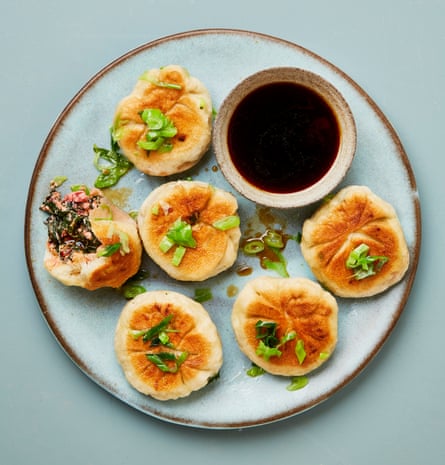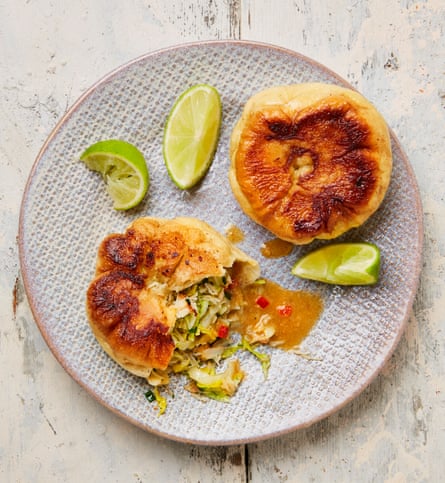
I tend to eat more Chinese food when I am out and about than when I’m cooking at home. The biang biang noodles that I can get at my local Xi’an Impression in north London, for example, demand to be eaten rather than replicated. When I’m not eating far too much there, however, it’s the books of Fuchsia Dunlop that encourage me and my team to try our hand. Today’s Shanghai pot sticker buns are a result of my colleague Jake Norman recently getting lost in, and inspired by, her Land of Fish and Rice.
Shanghai buns
This dough can be steamed to make baos or fried to make pot stickers; if you’re partial to an extra-crisp shell, they can also be deep-fried. Once you’ve made the dough, use whatever fillings you fancy to turn it into dumplings. I’ve given some ideas in the subsequent two recipes.
Prep 10 min
Prove 50 min+
Cook 1 hr
Makes 15 buns
300g strong white bread flour, plus 1½ tbsp extra for dusting
1 tsp fast-action dried yeast
½ tsp caster sugar
½ tsp baking powder
¼ tsp salt
½ tsp sesame oil
175ml lukewarm water
350-400g your filling of choice (see below for ideas)
3 tbsp vegetable oil
1 star anise
Dipping sauce or black rice vinegar, to serve
Put the first five ingredients in the bowl of a stand mixer fitted with the dough hook, keeping the yeast and salt separate and on opposite sides. Mix on a medium speed, then beat in the sesame oil and 175ml of lukewarm water until it forms a dough. Turn up the speed to medium-high and mix for 10 minutes more, until smooth and pliable. Shape the dough into a ball, return to the mixer bowl, cover with a damp cloth and put in a warm place for about 50 minutes to an hour, to prove until doubled in size.
Take the risen dough out of the bowl and put it on a lightly floured work surface. Knead well to knock out all the air, then roll into a 4cm-wide sausage. Cut this into 15 pieces of about 30g each, then, using a rolling pin, roll each piece into a 3mm-thick, 9cm-diameter disc and flour generously.
To shape the buns, put one disc in the palm of your non-dominant hand and put a spoonful of your filling of choice in the middle – I’ve given a couple of filling ideas below, but you can just about put anything you fancy inside. Use your other hand to lift the edges of the disc up and over the filling, so they meet at the top and enclose it. Use your fingers to twist and seal the top edges together, so it now looks like a money bag. Pinch and twist the peak into a spiral, then tear off and discard the top half-centimetre of dough. Put the dough spiral side down on a lightly floured surface and repeat with the remaining discs of bun dough.
To cook the filled buns, put the vegetable oil in a large (28cm), nonstick frying pan for which you have a lid on a medium-high heat. Once it’s hot, take off the heat and carefully arrange the buns seam side down in the pan, so they cover its base; it’s OK if they touch slightly, but you don’t want them to be snug. Return the pan to the heat and fry the buns for two minutes, until golden and starting to crisp up underneath. Taking great care – it might spit! – pour 160ml boiling water around the edges of the pan (ie, not over the buns), add the star anise, cover the pan with its lid and leave to steam for six minutes. Remove the lid and carry on cooking uncovered until all the water has evaporated and the buns are cooked through.
Turn off the heat and use tongs carefully to lift each bun fried side up on to a large plate. Serve with your favourite dipping sauce or a small bowl of black rice vinegar.
Rainbow chard and tofu buns with sweet ginger dipping sauce
This is a great vegetarian filling for buns and hand pies alike. If you want to get ahead, make the filling and dipping sauce the day before. And if you prefer, use shop-bought dumpling wrappers to make the dumplings.
Prep 15 min
Cook 30 min
Cool 1 hr
Fills 15 buns
1 tbsp vegetable oil
3 garlic cloves (15g), peeled and crushed
5cm piece fresh ginger (10g), peeled and finely grated
1 red chilli (10g), stems, pith and seeds removed, finely chopped
4 spring onions, trimmed and thinly sliced, white and green parts kept separate
30g stem ginger, finely chopped
400g rainbow chard, stalks and leaves separated, stalks finely chopped, leaves roughly shredded
Fine sea salt and black pepper
225g silken tofu, drained
For the dipping sauce
½ tsp toasted sesame oil
30ml soy sauce
50ml syrup from the stem ginger jar
10ml Chinkiang (or black rice) vinegar
½ tsp lime juice
Put the oil in a large saute pan on a medium-high heat, then add the garlic, ginger, chilli and spring onion whites, and stir-fry for two minutes, until sizzling and fragrant. Stir in the stem ginger, chard stalks, a half-teaspoon of salt and a good grind of pepper, and fry, stirring occasionally, for five minutes, until the stalks are tender. Add the chard leaves and cook, stirring often, for five minutes more, until wilted.
Meanwhile, put the tofu in a large bowl and whisk vigorously for 30 seconds, until slightly creamy. Add the chard mixand a quarter-teaspoon of salt, stir to bind everything together, then set aside to cool.
Put the first four ingredients for the dipping sauce into a small saucepan with a tablespoon of water, bring to a boil and cook over a medium-high heat for three minutes. Tip into a small bowl and stir in the lime juice.
If you’re using the mix in Shanghai buns, fill and cook the buns according to today’s first recipe. Once you’ve removed the lid after steaming and the water has evaporated, scatter in the spring onion greens and cover the pan again for 20 seconds before transferring the buns to the serving plate. Serve with the dipping sauce on the side.
White crab and cabbage buns with brown crab butterscotch

The words “crab” and “butterscotch” aren’t often put together, but trust me on this one. Mixed with egg or mayonnaise, this also makes a great tart or sandwich filling, incidentally.
Prep 10 min
Steep 20 min
Chill 20 min
Cook 30 min
Fills 15 buns
For the filling
350g chinese (or napa) cabbage, shredded
Fine sea salt and black pepper
200g white crab meat
1 tsp tarragon leaves, roughly chopped
2 tbsp chives, finely chopped
1 tbsp coriander, finely chopped
2 tsp light soy sauce
2 tsp fish sauce
30g unsalted butter, melted
1 tsp honey
2 tsp plain flour
1 lime, zest finely grated, to get 1 tsp, then cut into 6 wedges
For the crab butterscotch
40g unsalted butter
2 tsp demerara sugar
1 tsp soy sauce
½ red chilli (5g), stem, pith and seeds removed, flesh roughly chopped
50g brown crab meat
½ tsp lime juice
Start by making the filling. Put the cabbage in a large colander set over a bowl, sprinkle over an eighth of a teaspoon of salt, mix well and leave for 20 minutes. Working one handful at a time, squeeze to extract as much water from the cabbage as possible, then put the shredded cabbage in a large bowl with all the other stuffing ingredients and a good grind of black pepper. Mix well and refrigerate for 20 minutes. Use to fill Shanghai buns and cook as in today’s first recipe, or to fill shop-bought dumpling wrappers.
Five minutes before serving (or, if you’re making it to go with Shanghai buns, when the buns are steaming), make the crab butterscotch. Put the butter, sugar, soy, chilli and an eighth of a teaspoon of salt in a small saucepan on a medium-high heat. Simmer for 90 seconds, until thick and glossy, then take off the heat. Add the brown crab meat, lime juice and a teaspoon of water, and stir until silky and well mixed in. Serve immediately with the lime wedges to squeeze alongside.



